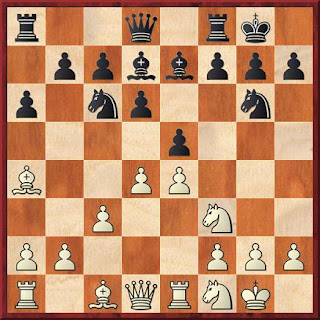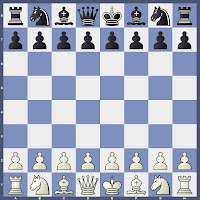Steinitz the incorrigible experimenter!
Recently, I came across the following position while studying Steinitz's games, and was stunned. The father of modern chess and the first world champion, playing black against Lasker (to whom he had lost his title only a few months back), had the audacity and 'creative recklessness' to put his pieces back in their den....after 17 moves, few of them haphazardly, more importantly....disobeying his own postulates!!
But.....
....despite its blatant ugly look, Black is not all that bad, and if he had played his penchant ....f6 (he was fond of f6 as black and f3 as white, in order to fortify his center), at some point and, or, not moved his g-pawn & f-pawn as he did, a few moves later much against his principle, he may not have lost or even if he had lost, not this bad!
Emanuel Lasker - William Steinitz, Hastings - 1895
I would be doing a gross injustice to show you the game starting from this point on, as obviously, one would be interested in knowing how he managed to reach this position!
But, we shall not be observing this game in a mundane way; we shall follow the game through the 'lens' provided by Mr.Steinitz himself (text in blue italics)....yet....
....we still may not succeed in finding a 'why'?
1) P - K4 2) KKt - B3 3) B - Kt5 4) B - R4 5) O - O 6) P - QB3 7) P - Q4
----------- --------------- ------------- ----------- --------------- ------------- ---------------
P - K4 QKt - B3 P - QR3 P - Q3 KKt - K2 B - Q2 KKt - Kt3
8) R - K1 9) QKt - Q2 10) Kt - B1
----------- --------------- --------------
B - K2 O - O
(this was the notation prevalent in his times!)
......I can hear some of you cursing me for the 'torture'..... so,
1) e4 e5; 2) Nf3 Nc6; 3) Bb5 a6; 4) Ba4 d6; 5) OO Nge7; 6) c3 Bd7; 7) d4 Ng6; 8) Re1 Be7; 9) Nbd2 OO; 10) Nf1
The variation which bears his name is still in vogue, and this position is contemporary!
10) .....Nh4 gets top billing here..... and the move......
10) ......Qe8!?
....played by Steinitz, threatening 11.....Nd4, comes fourth in the hit list, next to 10).....b5; and 10).....Bg4
"The most favorable points of development for the Queen are Q2 (d7 in this case) after developing the QB; or QB2 (c7) as well as QKt3 (b6) after moving P QB3 (c6). The latter development is especially attacking in forms of openings where the KB is played to QB4 (c5). It is rarely good to play Queen to K2 (e7) or KB3 (f6) in the opening, but such posts may sometimes be selected without disadvantage when the adversary has already played P QB3 (c3) or is otherwise prevented from bringing out his QKt QB3 (Nc3), whence the Queen would soon be attacked by Kt Q5 (Nd5). In some of the close games, the Queen may be developed at QR4 (a5) after moving the QBP (c-pawn) in order to post the KR at Q sq. (Rfd8) and the QR at QB sq. (Rac8) after developing all the minor pieces."
Rest assured, these postulates by this great player forms the bedrock of chess principles and an astute student would benefit a great deal in trying to understand what he says and incorporate them in his thought process. But due care must be taken not to just copy it or apply it without applying one's mind in trying to understand its application under various circumstances.
11.Bc2 Kh8!? N...... then and till date!!
Nobody in the past 120 years had the audacity to repeat this move, in this position!
The only explanation that I can give for this move by Steinitz has been given by me in the title for this post......"incorrigible experiment"!
We need to follow the game a little further to read Steinitz's mind!
12.Ng3?! Bg4!?
Self-violation - 1
"The QB is mostly developed at Q2 (d7 in this case) or K3 (e6), but in some openings he can be kept at home for a long time until P KB4 (f5) can be played with advantage, and in case the adversary capture that P with the KP (ef5), an excellent game will often be obtained by retaking with the Bishop. As already stated it is often useful to keep the respective Bishop within reach of the B sq (Bishops original square!) on the side on which the King has Castled. It is usually best to keep both Bishops in communication with both wings and for that reason as well as on account of the superior value of the Bishop it is very rarely of advantage to pin an adverse Knight. Notably should the pinning of the hostile K Kt (Nf3) by QB KKt5 (Bg4) be avoided excepting when some clear advantage or compensation can be perceived. For the opponent by attacking the Bishop with P KR3 (h3) will either effect an exchange more favorable to himself, or the Bishop will have to retreat with great loss of time. It is generally disadvantageous to allow the QB to be driven back to KKt3 (g6) out of communication with the other wing, especially when his Knight is posted at KB3 (f6)."
13.d5 Nb8; 14.h3 Bc8!
Compliance - 1
15.Nf5 Bd8!?
"....the KB is sometimes better posted at K2 (e7) in order to avoid its being exchanged for a Knight or for other defensive purposes."
And at times he goes any distance.....even to a distant 'planet d8', to avoid exchanging his Bishop!!
16.g4 Ne7; 17.Ng3!
I like the square g3 for Knight after the K Kt pawn has been moved!
17.....Ng8!!
Now we know the 'why' for 11.....Kh8!?
"After Castling on the King's side it is generally a good plan to remove the KKt in order to advance P KB4, and often Kt K sq (e8) is the best retreat for the purpose."
....and since 'e8' is inopportunely occupied by his Queen, the Knight landed on 'g8'.
18.Kg2 Nd7; 19.Be3 Nb6; 20.b3 Bd7?!
Self-violation - 2
"As already stated it is often useful to keep the respective Bishop within reach of the B sq (Bishops original square!)"
And on many occasions, Steinitz kept his Bishop on c1 (while playing White) and on c8 (while playing Black), true to his postulate, and effectively so!
The Bishop does nothing important here, except vacating that square which it occupied for another atrocious move and a manoeuvre ....!
21.c4 Nc8?!; 22.Qd2 Nce7? 23.c5 g6??
A sin!
Self-violation - 3
"In Castling on either side, it should be remembered, that the Rook pawn, Knight Pawn and Bishop Pawn on that wing in conjunction with a minor piece, generally a B or a Kt at b3 (f6) or at B sq (f8) form an excellent protection against the larger majority of attacks that can be planned by the opponent. The advance of either of these Pawns should therefore be postponed as long as possible, or else it will form an easier mark for the attack of the hostile men, and one of the minor pieces should be kept within convenient reach of B3 (f6) or B sq (f8) on the side on which the King has Castled."
A hole or a weak square are still more troublesome when the opponent is enabled to open the file on which they are situated for his Queens and Rooks. In the opening or middle part a hole or weak square are most dangerous in the centre or on the King's side before Queens are exchanged, but in the ending such weak points are generally more troublesome on the Queen's side. In the next place, it is a great advantage for the ending to have as many Pawns as possible unmoved on their original squares, for it is often most important to be able to gain a move by having the option of pushing a Pawn one or two squares.
Furthermore, we have already explained that three unmoved Pawns on- the King's side in conjunction with a minor piece form a strong -bulwark against an attack on that wing...."
.....and this is what he precisely violated here. Lasker immediately finishes him off!
24.Qc3 f5? 25.Ne5!? de5; 26.Qe5?
The materialistic machine is quick to spot and consider this move as really bad! It suggests 26.g5! and at hindsight, it appears very good;for Black is not weak only on the Kingside, in this position!
But human mind works in a different way, and there lies the beauty of Chess!
26.....Nf6; 27.Bd4
27.....fg4?
The silicon monster suggests a cold blooded, & equalising - '27....Kg8!!' It is very hard for human mind to perceive that Black can survive this position!!
The problem with material sacrifice is that, the defensive side, at times, has the option to return back the material, at opportune moment!
"Elegance of style when opportunity arises is no doubt an attribute of a great master, but the fact should never be lost sight of that the 'brilliant' sacrificing combinations can only occur when either side has committed some grave error of judgment in the disposition of his forces, and therefore, only very rarely in important games between first-class masters.
One of the most important exigencies in the conduct of the game is the exercise of the most critical judgment in estimating the relative value of the Pawns and pieces which must be strongly taken into consideration in effecting exchanges, as well as in the formulation of general principles for the guidance of play in all parts of the game."
28.hg4 Bg4?
The mistakes seldom come singly... needless to mention that here too he should have removed the King from that long diagonal with .....Kg8.
29.Qg5 Qd7; 30.Bf6 Kg8; 31.Bd1 Bh3; 32.Kg1 Nd5; 33.Bd8 Nf4; 34.Bf6 Qd2; 35.Re2! Ne2; 36.Be2 Qd7; 37.Rd7 Qf7; 38.Bc4 Be6; 39.e5 Bc4; 40.Nf5
.....and the long awaited Resignation by Black arrived!
This was a very strange experiment and exploration by this 'Vasco da Gama of Chess' and incidentally, it preceded one of the most famous victories ever to have happened on Chessboard.....
.....remember this position!? The famous seventh rank sortie by a Rook repeatedly put enprise!
Steinitz - Von Bardeleben , Hastings, 1895
When this extreme experiment, flouting all the principles of play can escape denouement, then, imagine how it's adherence would manifest itself....
I leave you with this observation by Steinitz on the royal game that we indulge ourselves in....
"The practice of our noble pastime is in no way influenced by any element of chance, excepting that of temporary individual dispositions, which after all forms a most important element of strength, and the results of Chess contests are therefore strictly based on a scientific and logical foundation. Both parties are placed on a perfectly equal footing on starting, as regards the forces and their respective powers, and the same rules regulate the movements or actions of the combatants. It is, therefore, purely a battle of the reasoning qualities that decides the issue in a, game of Chess, and the infinite variety of possible combinations in playing the game afford the widest scope for the exercise, and, therefore, the training of the logical as well of the imaginative faculties of mind."
....and I hope to write more about Steinitz in my subsequent articles!
Till then....






.jpg)
.jpg)

Comments
Post a Comment